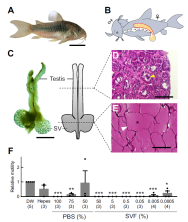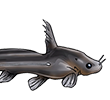Yoshida, J., Yamamoto, M., Kamiya, J., Kondo, A., Sakaguchi, Y., Morino, N., Saito, T., Kohda, M., Awata, S., Sato, B. and Miyado, K., 2025. Seminal vesicle protein ca CA12 in Corydoras aeneus inhibits sperm motility for sperm drinking. Journal of Experimental Biology, 228(9), p.jeb250293.
https://doi.org/10.1242/jeb.250293
https://journals.biologists.com/jeb/art ... 293/367961
ABSTRACT
Seminal vesicle (SV) secretions enhance fertilization by regulating sperm motility and fertilization capacity, and by forming plugs that prevent mating with other males. Although SVs are rare in teleosts, certain species, such as Corydoras spp., do possess them. In Corydoras spp. and other species that exhibit sperm drinking or related behaviors, females attach their mouths to the males' genital pore to ingest semen, a reproductive behavior known as sperm drinking. However, the major proteins and functions of seminal vesicle fluid (SVF) in Corydoras remain unidentified. This study aimed to identify the SVF proteins in Corydoras aeneus and clarify the functions of the identified major SVF proteins. The SVF of this species was found to be highly viscous with a high protein concentration. Sperm motility was strongly suppressed in the presence of the SVF. We identified three SVF proteins – alpha-2-macroglobulin (A2M), carbonic anhydrase 12 (CA12) and lymphocyte antigen 6 (Ly6) – through RNA sequencing (RNA-Seq), LC-MS/MS and amino acid sequencing. Additionally, we found that the identified CA12, termed ‘caCA12,’ was degraded into about 10 kDa and 33 kDa polypeptides containing the CA domain. The 33 kDa polypeptide with the CA domain was found to inhibit sperm motility. The identified SVF proteins, including caCA12, may play a role in keeping sperm in an immotile state until they are close to the female ova, facilitating the remarkable sperm drinking reproductive process observed in C. aeneus.

- Fig. 1. Male reproductive organs related to reproduction and the
function of seminal vesicle fluid (SVF) in Corydoras aeneus.
(A) Photograph of an adult male C. aeneus. Scale bar: 1 cm. (B) Illustration of
sperm drinking, a reproductive behavior in Corydoras spp. The white duct in
the female is the gastrointestinal tract, and the upper yellow sac is the ovary.
In sperm drinking, Corydoras sperm migrate through the female
gastrointestinal duct and fertilize the eggs at an external place between the
pelvic fins. (C) Morphology of the male reproductive organ of Corydoras.
Photograph (left) and diagram (right) of the male reproductive organ. Dashed
lines on the diagram indicate the histological location of the testis and seminal
vesicle (SV). Scale bar: 2 mm. (D) Hematoxylin and eosin (HE) staining of the
testis. Scale bar: 200 μm. Yellow arrowhead indicates spermatozoa in a cyst.
(E) HE staining of the seminal vesicles. Scale bar: 200 μm. White arrowhead
indicates secretory epithelium and asterisk indicates eosin-positive SVF
inside the epithelium. (F) Corydoras sperm motility in Hepes buffer, PBS
buffer or SVF at different dilutions. Sperm motility values were normalized to
the number of motile spermatozoa in the control condition using distilled water
(DW). Independent experiments were performed using spermatozoa collected
from different Corydoras males. PBS solution was undiluted (100% PBS), or
diluted to 75% PBS and 50% PBS with DW; 50% SVF in DW was undiluted
(50% SVF), or diluted to 5% SVF, 0.5% SVF, 0.05% SVF, 0.005% SVF and
0.0005% SVF. Data are means+s.d. Numbers in parentheses are number of
male C. aeneus examined. Unpaired two-tailed Student’s t-test was
conducted (*P<0.05, **P<0.01, ***P<0.001 versus DW).

- Fig. 5. Mechanism showing the role of SV proteins in sperm drinking.
In SVF, caCA12 inhibits sperm motility immediately after male ejaculation
and within the gastrointestinal tract, preventing sperm from expending
energy prematurely. The viscosity of SVF, combined with the enzymatic
activity of caCA12, acts as a barrier, preventing sperm from diffusing into the
gastrointestinal tract and so protecting sperm from digestion. After passing
through the gastrointestinal tract, caCA12 is digested or removed from the
sperm surface, allowing sperm to regain motility and move towards the eggs.
A2M, alpha-2-macroglobulin; Ly6/uPAR, lymphocyte antigen 6/urokinasetype
plasminogen activator receptor.




